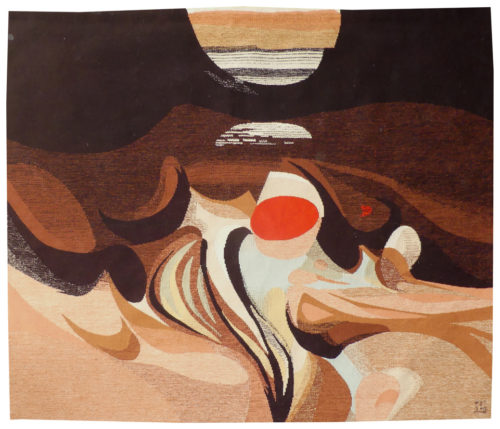-
Aubusson tapestry woven in the Legoueix workshop. Complete with signed label, n°1/6. Circa 1970.Originally a sculptor exploiting very diverse materials (steel, concrete, clay…), Borderie came to tapestry with immense enthusiasm in the 1950’s with the weaving of his first cartoon in 1957. Receiving encouragement from Denise Majorel, he was awarded the Grand Prix National de la Tapisserie in 1962. In 1974 he was appointed as director at the Ecole Nationale des Arts Décoratifs at Aubusson but he resigned from this post shortly thereafter. He designed over 500 painted cartoons, abstracts using simple shapes, shading in a limited palette of colours and weaving with gros points. Despite its warm colours and lyrical shapes (notably the sinuous vertical swirl, ressembling water currents), “Eaux vives” remains a one-off in Borderie’s work : the habitual muted colour scheme is broken here by the striking central red oval. Bibliography : Exhibition catalogue André Borderie « pour l’homme simplement », Angers, Musée Jean Lurçat et de la Tapisserie Contemporaine 1998 J.J. et B. Wattel, André Borderie et la tapisserie d'Aubusson, Editions Louvre Victoire, 2018
-
D'or et d'ombre (of gold and shade)
Originally a sculptor exploiting very diverse materials (steel, concrete, clay…), Borderie came to tapestry with immense enthusiasm in the 1950’s with the weaving of his first cartoon in 1957. Receiving encouragement from Denise Majorel, he was awarded the Grand Prix National de la Tapisserie in 1962. In 1974 he was appointed as director at the Ecole Nationale des Arts Décoratifs at Aubusson but he resigned from this post shortly thereafter. He designed over 500 painted cartoons, abstracts using simple shapes, shading in a limited palette of colours and weaving with gros points. Here we find the same preoccupations with light (and shadow) as in ‘les armes de la lumière’ (and as in Matégot's work). Borderie was also woven by workshops other than Legoueix in Aubusson, Rado, Daquin and, more confidentially, Chartron in Angers (who wove Jorj Morin in particular). Bibliography : Exhibition catalogue André Borderie « pour l’homme simplement », Angers, Musée Jean Lurçat et de la Tapisserie Contemporaine, 1998 Exhibition Catalogue André Borderie et la tapisserie d’Aubusson, Aubusson, Manufacture Saint-Jean, 2018Tapestry woven in the Cartron workshop. With signed label, n°1/1. Circa 1970. -
Vent de sable (sandstorm)
Aubusson tapestry woven in the Legoueix workshop. With signed label, n°EA/2. Circa 1970.Originally a sculptor exploiting very diverse materials (steel, concrete, clay…), Borderie came to tapestry with immense enthusiasm in the 1950’s with the weaving of his first cartoon in 1957. Receiving encouragement from Denise Majorel, he was awarded the Grand Prix National de la Tapisserie in 1962. In 1974 he was appointed as director at the Ecole Nationale des Arts Décoratifs at Aubusson but he resigned from this post shortly thereafter. He designed over 500 painted cartoons, abstracts using simple shapes, shading in a limited palette of colours and weaving with gros points. A dynamic abstraction with a limited colour scheme running from orange to brown, abstract motifs which play on the plastic effect of light passing through the colours : a classic cartoon from André Borderie. Bibliography : Exhibition catalogue André Borderie « pour l’homme simplement », Angers, Musée Jean Lurçat et de la Tapisserie Contemporaine 1998 J.J. et B. Wattel, André Borderie et la tapisserie d'Aubusson, Editions Louvre Victoire, 2018 -
Les armes de la lumière (weapons of light)
Originally a sculptor exploiting very diverse materials (steel, concrete, clay…), Borderie came to tapestry with immense enthusiasm in the 1950’s with the weaving of his first cartoon in 1957. Receiving encouragement from Denise Majorel, he was awarded the Grand Prix National de la Tapisserie in 1962. In 1974 he was appointed as director at the Ecole Nationale des Arts Décoratifs at Aubusson but he resigned from this post shortly thereafter. He designed over 500 painted cartoons, abstracts using simple shapes, shading in a limited palette of colours and weaving with gros points. ‘At the centre of André Borderie's painted and woven work is light’ (F. de Loisy in Exhibition Catalogue André Borderie ‘pour l'homme simplement’, Angers, Musée Jean Lurçat et de la Tapisserie Contemporaine, 1998 p.7). This observation has manifesto value here, with concerns close to those of Matégot (cf. ‘Ombres et lumières’, ‘Piège de lumière’...). Bibliography : Exhibition catalogue André Borderie « pour l’homme simplement », Angers, Musée Jean Lurçat et de la Tapisserie Contemporaine, 1998 Exhibition Catalogue André Borderie et la tapisserie d’Aubusson, Aubusson, Manufacture Saint-Jean, 2018Tapestry woven in the Cauquil-Prince workshop. With signed label, n°1/1. Circa 1970.






